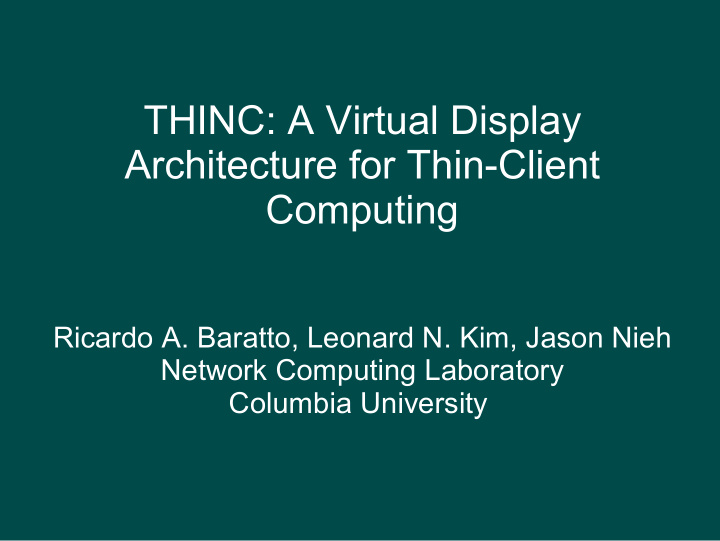



THINC: A Virtual Display Architecture for Thin-Client Computing Ricardo A. Baratto, Leonard N. Kim, Jason Nieh Network Computing Laboratory Columbia University
isolation...
...connectivity Source: Internet Mapping Project (http://research.lumeta.com/ches/map/)
dis-integration of the computer clusters and grid computing network storage
remote display display updates input
benefits
ubiquitous access
remote collaboration
online help
thin clients application processing and data stateless client secure server room
existing systems
existing performance problem PC ICA RDP GoToMyPC X NX VNC Sun Ray 0% 20% 40% 60% 80% 100% audio/video quality LAN WAN
THINC
virtual display architecture high performance remote display transparent operation
● system architecture ● display protocol ● translation ● delivery
system architecture
applications window system device driver framebuffer
interception and redirection applications high-level requests window system ✗ stateful client hurts mobility device ✗ app – window system driver synchronization framebuffer
interception and redirection applications high-level requests window system ✗ lose semantics: device difficult to encode driver raw pixels framebuffer
virtual display architecture applications window system display updates virtual device driver input events
benefits applications window system Standard Interface virtual device driver
benefits applications Leverage window existing system technology virtual device driver
benefits Simple, low-level protocol display updates virtual device driver
benefits Simple, stateless client display updates virtual device driver input events
display protocol Inspired by Sun Ray protocol 2D Primitives ● copy ● solid and tile fill ● bitmap fill ● raw Video
two key problems how do we translate from application commands to the display protocol? how and when do we send display updates?
translation use and preserve semantic information for efficient translation
translation ● use semantic information when doing translation
use request semantics to generate update application req: fill window W, color C window system req: fill [x,y,w,h] color C THINC update: solid fill [x,y,w,h] color C
translation ✔ use semantic information when doing translation ● preserve semantic information throughout the system
preserving semantics: offscreen rendering display draw abcde copy abcde offscreen regions
offscreen rendering (cont) offscreen region command log merge, clip, and discard commands as needed
using and preserving semantics: video ● reuse existing hardware acceleration application interfaces ● YUV (luminance-chrominance) color space – format independence – client hardware acceleration (scaling for free)
delivery maximize interactive response of the system
delivery ● transmit updates as soon as possible ● merge, clip, and discard updates as needed
shortest remaining size first scheduler real time client buffer queue 1 C n C 3 C 2 C 1 ... . cmd . size . queue p
implementation ● X/Linux server – ongoing: windows server ● X/Linux, windows, PDA, Java clients
experimental results ● web and video performance – comparison to existing systems – Internet 2 sites around the globe
LAN WAN “ ” 802.11g
web browsing performance PC ICA RDP GoToMyPC X NX VNC Sun Ray THINC 0 0.5 1 1.5 2 2.5 3 per web page latency (s) Desktop LAN Desktop WAN 802.11g PDA
a/v playback quality PC ICA RDP GoToMyPC X NX VNC Sun Ray THINC 0% 20% 40% 60% 80% 100% audio/video quality Desktop LAN Desktop WAN 802.11g PDA
MN MA PA NY CA NM
FI IE CA KR PR
Internet2 web browsing performance 2 page latency (s) 1.5 1 0.5 0 ny pa ma mn nm ca can pr ie fi kr location
Internet2 a/v playback quality 100% playback quality 80% 60% 40% 20% 0% ny pa ma mn nm ca can pr ie fi kr location
demo
conclusions THINC : ● virtual display architecture transparently leverages existing display infrastructure ● efficient translation by using and preserving semantic information from display request ● delivery mechanisms increase responsiveness of the system
for more info... http://www.ncl.cs.columbia.edu
Recommend
More recommend